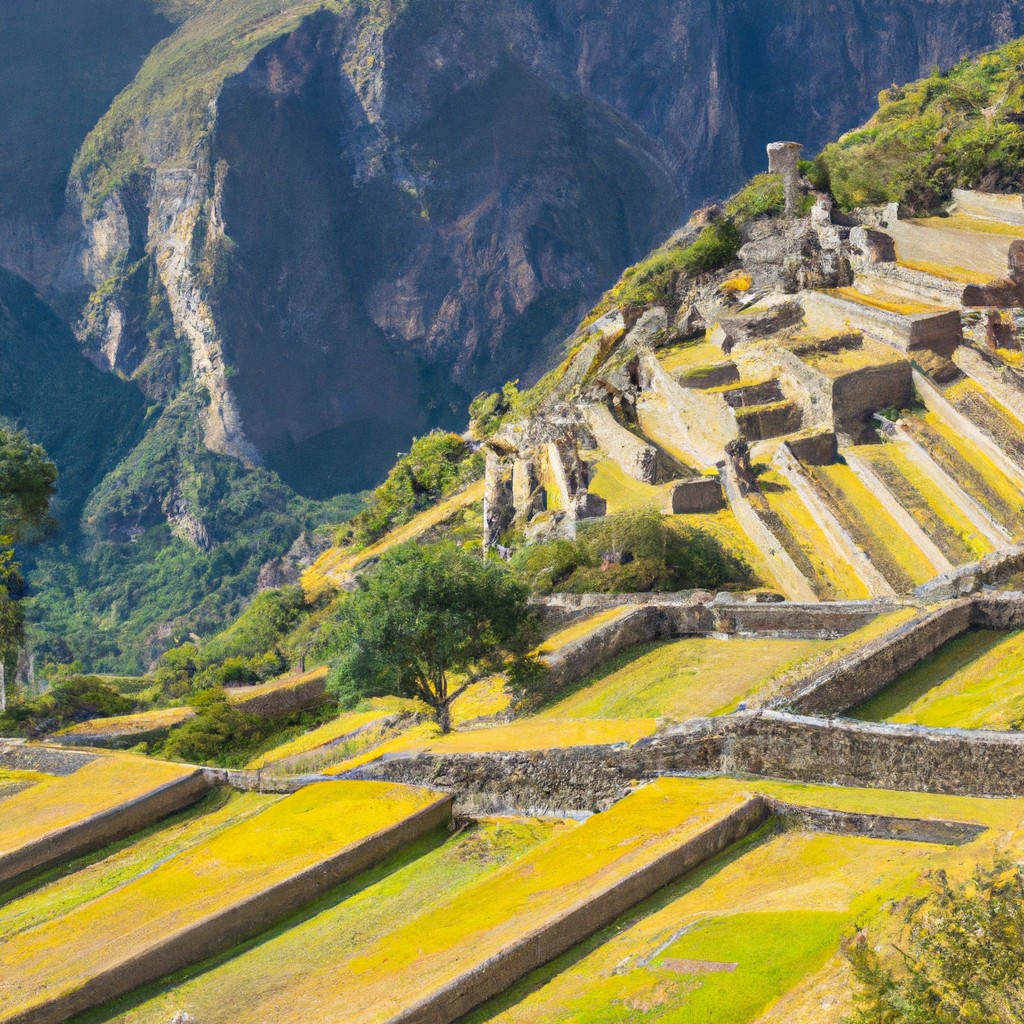Inca agriculture employed advanced techniques and systems to support their civilization in the harsh Andean environment.
Look Inside:
Environment

The Inca civilization thrived in a landscape that was as diverse as it was challenging. Situated mainly in the Andean region, they dealt with mountainous terrains, fertile valleys, and arid coastal plains.
Firstly, the altitude variance played a significant role. High elevations meant cooler temperatures, which influenced the types of crops that could grow and the agricultural techniques used. Ingenious terracing methods were developed to maximize arable land and prevent soil erosion, supported by advanced irrigation practices to optimize water use.
Secondly, the microclimates across the Incan empire allowed for a variety of crops. Each ecological zone had its specialty, from potatoes in the cold highlands to maize in the warmer, lower areas.
The diversity of the environment necessitated a deep understanding and respect for nature, which was integral to their farming practices. They adapted to their surroundings instead of working against them, ensuring sustainable crop production through intimate knowledge of weather patterns and soil conditions.
Organization & Methods
The Incas were master planners, cleverly allocating specific lands for specific uses, a technique that maximized efficiency. Terrace farming was one prominent method, which turned steep slopes into arable farmland, preventing erosion while aiding irrigation. These terraces can still be seen snaking across the Andes today.
They also engineered sophisticated irrigation systems to combat the dry conditions of the Andes. By channeling water from melting snow and mountain springs through canals, they ensured consistent moisture to their crops, crucial for their survival and growth.
Moreover, they practiced fallowing, allowing soil to recover nutrients by leaving it unplanted for periods. This rotation not only nurtured the soil but also reduced the risk of pest infestations, showing a deep understanding of ecological balance and sustainability long before these terms became widespread.
Crops
The Incas were masterful agriculturalists, cultivating over 70 crop species in a diversity of climates. These included staples like potatoes, which they developed in many varieties for different altitudes and conditions. Maize was significant in lower elevations, but the versatility of quinoa as a high-altitude grain was paramount.
Additionally, they grew peppers, tomatoes, and beans, enriching their diet and culinary traditions. The adaptability of the Incas to their environment is further seen in how they cultivated crops that thrived across varied terrains from lush valleys to high mountain slopes. This diversity not only supported their daily sustenance but also played a crucial role in their ceremonies and religion.
Alongside these, they also grew lesser-known crops such as oca, an important tuber, and achiote, used for both culinary and dyeing purposes. The integration and balance of these crops underscored their expertise and ongoing commitment to optimizing yield and sustainability within their harsh and varied environment.
Animal Husbandry
Llamas and alpacas were central to Incan society, serving not just as beasts of burden but also as sources of wool and meat. Unlike other civilizations, the Incas did not use these animals for plowing or pulling carts, but they were indispensable for transporting goods across the Andean mountains.
The wool from these animals was crucial in the cool Andean climate, used in making clothing and blankets that were vital for survival in high altitudes. This practice not only capitalized on the animals’ natural abilities but also demonstrated a keen understanding of their environment.
Moreover, the Incas were strategic in the breeding of these animals, aiming to improve stock and maintain a sustainable source of resources. They may not have had modern genetics, but their selective breeding techniques ensured healthy, resilient herds.
Their approach was practical yet sophisticated, reflecting deep integration of animal husbandry into their economy and culture, ensuring their empire thrived in harsh landscapes.
Agriculture & Religion
The Incas viewed their agricultural practices as deeply intertwined with their religious beliefs. They believed that their successes in farming were gifts from the gods, particularly from Pachamama, the Earth mother, and Inti, the sun god, who were central to their cosmology.
Farmers often performed rituals and offered sacrifices to these deities to encourage favorable growing conditions and a bountiful harvest. Key planting and harvesting periods were marked by community-wide celebrations, reinforcing the social cohesion and shared belief system.
Additionally, the Incas used astronomical observations to plan agricultural activities. They constructed specialized observatories, such as the famous Sun Temple at Machu Picchu, which allowed them to track solar alignments and optimize planting cycles according to celestial events.
This sacred relationship with nature emphasized the balance and harmony necessary for their survival, guiding not just farming techniques but also societal values and governance.




